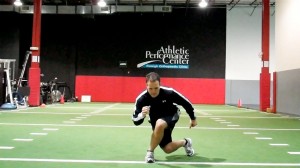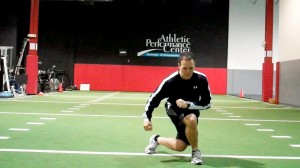Brian Schiff’s Blog
Injury Prevention, Sports Rehab & Performance Training Expert
Unearthing the cause of anterior knee pain and ridding our patients and clients of it is one of the never ending searches for the “Holy Grail” we participate in throughout training and rehab circles. I honestly believe we will never find one right answer or simple solution. However, I do think we continue to gain a better understanding of just how linked and complex the body really is when it comes to the manifestation of knee pain and movement compensations.
We used to say rehab and train the knee if the knee hurts. It was simply strengthen the VMO and stretch the hamstrings, calves and IT Band. Slowly, we began looking to the hip as well as the foot and ankle as culprits in the onset of anterior knee pain. The idea of the ankle and hip joint needing more mobility to give the knee its desired level of stability has risen up and seems to have good traction these days.
Likewise, therapists and trainers have known for some time that weak hip abductors play into increased femoral internal rotation and adduction thereby exposing the knee to harmful valgus loading. So, clam shells, band exercises and leg raises have been implemented to programs across the board.

Single Leg Resisted Hip External Rotation
As a former athlete who has tried his hand at running over the past 5 years, I have increasingly studied, practiced and analyzed the use and importance of single leg training and its impact on my performance and injuries. As I dive deeper into this paradigm, I continue to believe and see the benefits of this training methodology for all of my athletes (not just runners).
As a therapist and strength coach, it is my job to assess movement, define asymmetries and correct faulty neuromuscular movement patterns. To that end, I have developed my own assessments, taken the FMS course, and increasingly observed single leg strength, mobility, stability and power in the clients I serve. Invariably, I always find imbalances – some small and some large ones.
What are some of the most common issues I see?
It is common knowledge in the medical community that treating patellofemoral joint pain (PFJP) is one of the most frustrating and difficult tasks to complete as there appears to be no standard way to do so. While clinicians strive to find the right recipe or protocol (I don’t believe there is just one by the way), researchers press on to find more clues.
A new article released in the April 2011 Journal of Orthopaedic & Sports Physical Therapy seeks to bring clarification to a particular exercise pattern commonly used in rehab circles. The three exercises they looked at were:
- Forward step-up
- Lateral step-up
- Forward step-down
In the study, the authors looked at 20 healthy subjects (ages 18-35 and 10 males/females) performing the separate tasks with motion analysis, EMG and a force plate. The goal was to quantify patellofemoral joint reaction force (PFJRF) and patellofemoral joint stress (PFJS) during all three exercises with a step height that allowed a standard knee flexion angle of 45 degrees specific to each participant.
Key point: Previous research has been done to indicate that in a closed chain setting, knee flexion beyond 60 degrees leads to increased patellofemoral joint compression and this may be contraindicated for those with PFJ pain or chondromalacia. Also keep in mind that most people with PFJ complain of more pain descending stairs than ascending stairs.

In the study, the participants performed 3 trials of 5 repetitions of each exercise at a cadence of 1/0/1 paced with a metronome. The order of testing was randomized for each person. The authors used a biomechanical model to quantify PFJRF and PFJS consisting of knee flexion angle, adjusted knee extensor moment, PFJ contact area, quadriceps effective lever arm, and the relationship b/w quadriceps force and PFJRF.
Now on to the results……
Many people like to do lunges in the gym. Many people do them wrong. Some simply do not know proper form, while others have mechanical issues preventing them from executing proper form.
Unfortunately, many clients struggle to keep the knee in line with the foot, and the knee often caves inward. Even with verbal, visual and tactile cues, they may still struggle to master the proper form due to flexibility and strength imbalances. This may have to do with limited ankle mobility, but for the purposes of this post, I want to address the hip. More specifically, people often lack mobility, stability and strength in the hips.
I recently wrote two columns for PFP Magazine featuring two exercises I use to clean up lunge form:
- Torso Rotational Lunges
- Diagonal Hip Flexor Lunge Step
The torso rotational lunge is great for integrated muscle activation of the gluteus medius, while I utilize the diagonal hip flexor lunge step to address hip flexor tightness and limited thoracic spine mobility.

Torso Rotational Lunge

Diagonal Hip Flexor Lunge Step
In these columns, I specifically review regressions and progressions. So, whether you train clients or simply want to take your lunges to the next level, check out the full columns online at PFP below:
Click here for the Torso Rotational Lunges
Click here for the Diagonal Hip Flexor Lunge Step
Looking for more cutting edge training tips and rehab/injury prevention strategies? Subscribe to my members’ only Training & Sports Medicine Update available at www.BrianSchiff.com.
First off, I want to extend warm Holiday wishes to all of you reading this blog!! As I sit at home on Christmas Eve morning, I am quietly reflecting back on a big year of accomplishments and changes I experienced in 2010. It is often hard to take time to appreciate your blessings, Because as a society we are driven to conquer the “next thing.” However, I have been trying to get better at taking time to savor life’s victories.
Last year, I ran my first marathon (thankfully under 4 hours despite horrible cramps), sold my successful 10 year-old fitness business in Ohio, and moved to North Carolina to tackle a new venture at the Athletic Performance Center. The past year has truly been full of many changes and blessings.
Over the years, I have come to realize that the real gift in my profession is being able to help others. For me, I have an ability to reach consumers through my rehab and performance training, as well as my peers through blogging, speaking and products. If you read my blog, I hope that I have been able to help you even if it is only in the smallest way.
As I look ahead to 2011, I am excited for new opportunities and feel like it will be a big year of learning and exploration for me. That will translate into more sharing on this blog and in my monthly Training & Sports Medicine Update Newsletter. I am continuing to write for PFP Magazine through my online column and will share my latest post with you today on crossing lunges.
Performing a crossing lunge presents unique challenges to the body – challenges which often exploit muscle imbalances, mobility issues, and balance deficits. It is a rotational activity that is more challenging then it may appear.
I once had an athletic trainer question the safety of them in an exercise class I was teaching. She thought they were harmful for the meniscus in the knee. Hmmm…. If that is true , why would I do them? Well, like any exercise you do in the gym, there is always risk of an injury IF you do the exercise improperly. That is a key takeaway point. For the record, I never recommend an exercise I think is dangerous – in most cases it simply comes down to form and knowing your limitations.
Crossing lunges are very effective in strengthening the entire lower body, but particularly the hips. Whether choosing the backward or forward variation, they call for hip internal/external rotation, knee stability and ankle mobility. Beyond that, they are very functional for sport and athletic movement.
Think about field or court sports for a minute. How many times does an athlete cross over to dribble, scoop up a ball or evade a tackle? You may see the forward variation more, but the backward variation is seen as well with drop steps, pivot motions and even along the baseline in tennis.
So, if you train athletes or are an athlete, this is a great example to keep in your personal exercise tool box. I have included pictures of the forward and backward version below. See the link below the photos for my full column and explanation of how to do the exercise properly.

Backward Crossing Lunge (onto right)

Forward Crossing Lunge (onto right)
Click here to read my full online column, Functionally Fit, pertaining to this lunging exercise. Thanks for reading this, and I wish you all the best in the year to come!

